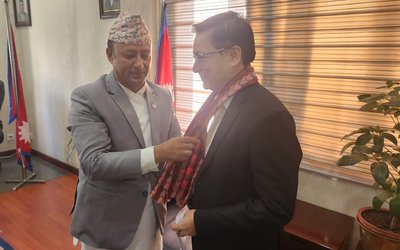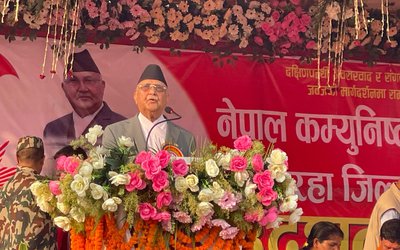How are the humanitarian courses important?
Hollingworth:We have already run 49 courses around the world and on each of these courses, we have had on an average 25-30 students. Both of us are used to be humanitarian aid workers and very importantly each course we have had drew a large contingent of local staff. In this course, the bulk of the students is indeed from Nepal and we are delighted to further the education for a great deal of humanitarian workers. As you have said, you have had many crises in your country in the last decades, which you have faced admirably. The class work we have, the advantage of our course, is that Nepalese students are sharing their extensive knowledge with other people from other continents, who also share theirs. So that’s in effect the essence of our course.
Land: Well. Although we are getting much better responding to natural disasters, they are creating more and more need, because big cities like Kathmandu, which are vulnerable to earthquake but are growing very quickly, which is same with other big cities around the world, where disasters may occur. So the courses like this are essential to train the people who will be the first responders to disaster and people from the locality to help them establish a mechanism which is going to meet relief and other needs of the future.
How important is it to train manpower at the time of humanitarian crisis?
Hollingworth: The first and foremost responsibility for such training is the responsibility of the government and your government has some excellent agencies and they have lots and lots of experiences. The first and foremost thing is a very strong cause, very good experiences with senior level people to respond to the crisis. What we are doing is improving the knowledge of locals and we are also grooming the knowledge of humanitarian workers globally by our policy of exchanging ideas. We have 2500 graduates from our courses. All of them have had a very competent, compressive and intense one-month course. More importantly, all of them exchange their ideas. There were 24 students and five experts and we exchanged 29 ideas and had every single discussion. We all are better qualified. This is our model course and we have to replicate it and we will be pleased to come back making arrangements. As this one is so successful, we love to come back to make the second course here. We have to say that Nepalese students on the course are outstanding and each and every one of them gave full attention during the whole course. It is a tremendous credit for them.
Land: In the future, the first responders after the disaster are the local people. In the minutes following the earthquake, I am sure neighbors and local populations were digging the people with their bare hands to help relatives and neighbors. Then, the next tier of responsibility is also going to the local people. It takes a while for the international organization to gear up to recruit and to bring their supply in and start work. So, it is really vital around the world whenever there is a risk of natural disaster that local organizations are at their best as they can be there to provide the immediate response and indeed to ultimately lead the total response along with their government. So our objective is always in three folds. One is to make them cautious, we bring the course to the students, rather than bringing the students in the course. It should be extremely practical and all are actually academic theoreticians, but they have long practical experiences. Finally, it is vital to say that the courses carry academic response. This is the reason this is part of well-renowned universities, with 175 in its history of existence. After the completion of the course, students have the certificate given by the world-renowned universities in recognition for the worldwide and practical experiences.
What does the course offer?
Hollingworth: Fordham University has many courses and most of them are domestic and most of the courses are for the students in America. This is the only course which travels and the university totally supports us. We can have a large number of national staff, which is the absolute essence of our program. We are here not to train internationals but by choice we prefer only to do with national staff because national staff are the first and most efficient responders to any disaster. Eventually in the aid world, they are the only responders.
Land: That certainly is the future. Just last year at the world humanitarian summit, the main humanitarian agencies got together and agreed what they called the great deal, which is, in the next few years, to make sure 25 percent of all humanitarian funding was channeled to the local organizations. That is just a beginning. I am sure that over the years that will expand and we really have a situation on which the traditional foreign NGOs and aid agencies are starting to say it is time for us to recognize the potential nature of local organizations. Those local organizations will be the ones we want to strengthen by providing training.
As Nepal is very vulnerable to natural disasters, including GLOF, landslides, floods and earthquakes, and add to this Nepal’s recent experiences of the bloody conflict, how will this help Nepali people?
Hollingworth: The syllabus we have covers every aspect of humanitarian assistance. We talk about natural disasters, we talk about conflict and we spend a lot of time on causes, answers and responses and the future response to them. We are sure that what hits any country, the people in our courses are being made aware all of the problems and a number of solutions that could be applied.
Land:The response is one important factor we look at. Of course, it is the vital life saving factor once the crisis happens. Similarly, we need to look at the response, building back better, making safer environment, so similar events create less damage. At the same time, you need to be looking at how the society can be better prepared to be able to cope with the event that happens. Many of the events as you listed, the natural disasters, we cannot prevent them. They happen. But what is important is to create the environment for as little a damage as it is possible. When they do hit, the society should recover as quickly as possible and have qualified and experienced people who can save lives in the immediate aftermath of the events.
We have spent a lot of time in disaster risk reduction. Actually, this is an essential factor for the country. Disaster risk reductions need a lot of time, lot of effort and lot of money. Often people have spent money to prevent something. Very often we spent money in reaction to something that happens. You will be safer if you spend money in disaster risk reduction. Your country is very aware of it.
What do you suggest for the management of the internally displaced population and refugees?
You are in the situation that many other countries have been facing. You have refugees from different parts of the world. There is the need to find the solution for them. You have a few options: either you can absorb them here or you can send them back or you can find someone to take them. Unfortunately, there are very few countries which want to take the refugees and sometimes it is very difficult to send the refugees back. They will stay in your country, with so many refugees, for a long time to come. The only solution for the refugee crisis is political. Political will between the nations, probably monitored and negotiated by other nations. In the case of IDPs, it is the internal problem. It is your own government to settle this. The government has made conducive environment and to say the people that your home is safe. You have also problems of stateless people here. The solution of all these problems is political. We can provide humanitarian assistance but the solution is political.
Land: Migration is a worldwide phenomenon and people are on the move in every part of the world. In the case of internal migration, it is sometimes very hard to separate the people from IDPs and those who migrated to the cities. It is very difficult. People leave the villages because of surrounding conditions. One has to accept the fact that migration is going to be long term, particularly as people sneak to the big cities. Cities are also in need to respond to those people. Experiences around the world show that this is going to be there for a long time.

Keshab Poudel
Poudel is the editor of New Spotlight Magazine.
- PM OLI MEETS PM MODI: No Progress:
- Apr 09, 2025
- PM OLI’S THAILAND VISIT: Flip Flop
- Apr 08, 2025
- FM Dr. Deuba’s India Visit: Mission Aborted
- Mar 26, 2025
- AMBASSADOR MAEDA TORU: Warm Regards
- Mar 24, 2025
- PRO-MONARCHY MOVEMENT: Rising Dissatisfaction
- Mar 23, 2025















